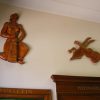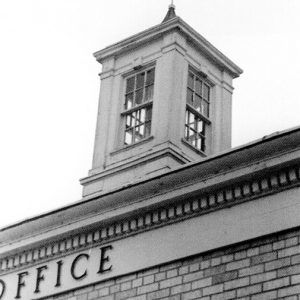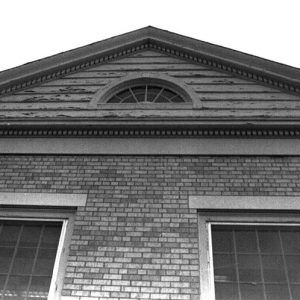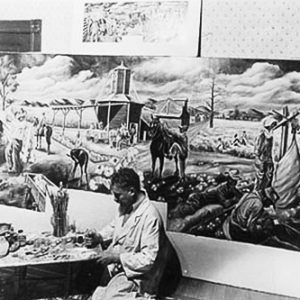calsfoundation@cals.org
Paris Post Office
The Paris Post Office in Paris (Logan County) is a one-story, brick-masonry structure designed in the Colonial Revival style of architecture. It features a mural financed through the U.S. Treasury Department’s Section of Painting and Sculpture (later renamed the Section of Fine Arts), a Depression-era stimulus project that promoted public art. Built in 1938, the post office was listed on the National Register of Historic Places on August 14, 1998.
In August 1937, Congress passed an appropriation bill providing a $23 million lump sum for construction of public buildings. Included in the allocation was $75,000 for a new post office for Paris, the seat of the eastern district of Logan County. A month later, Postmaster General James A. Farley and Treasury Secretary Henry Morgenthau officially allocated the money for site acquisition and construction. In mid-November, First National Bank of Paris received notice that its proposed sale of all of Block 11 of the Lyvissa Waddill addition was accepted, to be the site of the new post office. John H. Harris of Fort Smith (Sebastian County), the assistant U.S. district attorney, delivered a $6,250 check to seal the deal in April 1938.
In August 1938, the post office department notified the J. J. Fritsch Construction Co. of Dallas, Texas, that its bid of $47,000 for construction of the Paris Post Office was accepted. The company was to begin construction immediately, and the building was to be completed within 240 days. Work began within two weeks under the direction of Joseph E. Millett of Laplace, Louisiana, a construction engineer for the Treasury Department. The building was completed during the week of April 20, 1939, with postal employees occupying the top floor and the county extension service office occupying the basement area.
The new Paris Post Office was selected as the location for a mural through the Treasury Department’s Section of Fine Art through that agency’s “48 States Competition.” The winning selection, by German-born Joseph P. Vorst, of St. Louis, Missouri, was to be the most controversial of the Section’s activities in Arkansas.
Vorst’s winning sketch was described by Karal Ann Marling thusly: “The sketch showed a mean, bleak home place, as familiar in its way as a typical Iowa small town. Beneath a glowering sky, a ragged Negro, rooted to the soil by his ponderous boots, listlessly cultivates a scrap of scrubland with a manual tiller. A couple of spavined mules can barely muster enough energy to watch. His cabin, listing toward the dirt road that marks the central axis, is a ramshackle hovel, roofed in peeling tarpaper. As if to comment on domestic blight, the birdhouse in the yard lolls at a crazy angle on its pole, sounding a note of picturesque decay heightened by the piquant gaiety of a clump of sunflowers blooming nearby. The branches of a dying tree claw at the heavens like desperate fingers.”
Local reaction to the selection was fast and negative, exemplified by an October 28, 1939, letter from Paris Express editor John Guion to Congressman Fadjo Cravens: “Arkansas has been the butt of jokes for many years, I do not believe in perpetuating this attitude by placing a painting of this type upon the walls of our most prized building.” Vorst responded that he had made the sketch from life during a recent visit to Paris, adding that he was in contact with the Paris postmaster and would attempt to please Paris citizens, but not “at the sacrifice of genuine Art.” He said, “After all, I came to this country partly to attain artistic freedom.”
Vorst traveled to Paris again, and in the December 15, 1939, letter in which he described his meeting with community leaders, the artist wrote: “Experiences like these make me love this country of ours more and more. Where else in the World could one find the earnestness, the serious interest shown by one and all in every move of the government, local, state, and Federal, even in the choice of a subject for the village Post Office. Everyone has a voice and uses it. May we never lose our Democracy!”
A second letter thirteen days later described Vorst’s new sketch for the Paris Post Office: “At the left is an up-to-the-minute stock farm, in the center a cotton gin, at the right the process of weighing cotton, at right background picking cotton, at central left background a mine.” This scene, Karal Ann Marling notes, is the antithesis of the original drawing: “The mural is packed with houses, barns, stables, and gins, all of them spanking new, freshly painted, and soundly roofed.” The new design passed muster in Washington DC, and a contract to pay Vorst $740 for creation and installment of the Paris mural was prepared on January 2, 1940. After it was installed, Paris postmaster W. F. Elsken informed Rowan in a June 27 letter that Vorst’s painting, Rural Arkansas, “has gloriously met with the approval of all the citizens of this city.”
The Paris Post Office remains a remarkably intact expression of Depression-era Colonial Revival design in a government building. It remains in use in the twenty-first century.
For additional information:
“$75,000 Paris Post Office in Recommended List.” Paris Express, August 19, 1937, p. 1
“Arkansas Post Office Murals.” University of Central Arkansas. http://uca.edu/postofficemurals/home/ (accessed November 15, 2024).
Arkansas Post Office Murals Records. Arkansas State Archives, Little Rock, Arkansas.
“Bank Property Is Accepted for Post Office.” Paris Express, November 18, 1937, p. 1.
“Bids for Post Office Site Are Received.” Paris Express, October 7, 1937, p. 1.
Marling, Karal Ann. Wall to Wall America: A Cultural History of Post-Office Murals in the Great Depression. Minneapolis: University of Minnesota Press, 1982.
“Money Set Aside for Post Office; To Select Site.” Paris Express, September 16, 1937, p. 1.
“Paris Post Office.” National Register of Historic Places nomination form. On file at Arkansas Historic Preservation Program, Little Rock, Arkansas.
Park, Marlene, and Gerald E. Markowitz, Democratic Vistas: Post Offices and Public Art in the New Deal. Philadelphia: Temple University Press, 1984.
“Payment for Post Office Site Is Made.” Paris Express, April 14, 1938, p. 1.
“Post Office Moved to New Home Tuesday.” Paris Express, April 27, 1939, p. 1.
Smith, Sandra Taylor, and Mark K. Christ. Arkansas Post Offices and the Treasury Department’s Section Art Program, 1938–1942. Little Rock: Arkansas Historic Preservation Program, 1998. Online at http://www.arkansaspreservation.com/News-and-Events/publications (accessed November 15, 2024).
“Work on Building Started Monday.” Paris Express, September 15, 1938, p. 1.
Mark K. Christ
Arkansas Historic Preservation Program
 African Americans
African Americans Early Twentieth Century, 1901 through 1940
Early Twentieth Century, 1901 through 1940 Historic Preservation
Historic Preservation Post Office Art
Post Office Art Paris Post Office
Paris Post Office  Paris Post Office
Paris Post Office  Paris Post Office
Paris Post Office  Paris Post Office Detail
Paris Post Office Detail  Paris Post Office Front Door
Paris Post Office Front Door  Paris Post Office Interior
Paris Post Office Interior  Joseph Vorst's Post Office Mural
Joseph Vorst's Post Office Mural 



Comments
No comments on this entry yet.